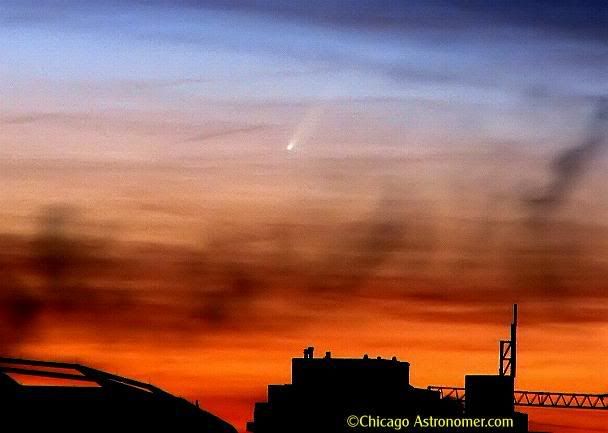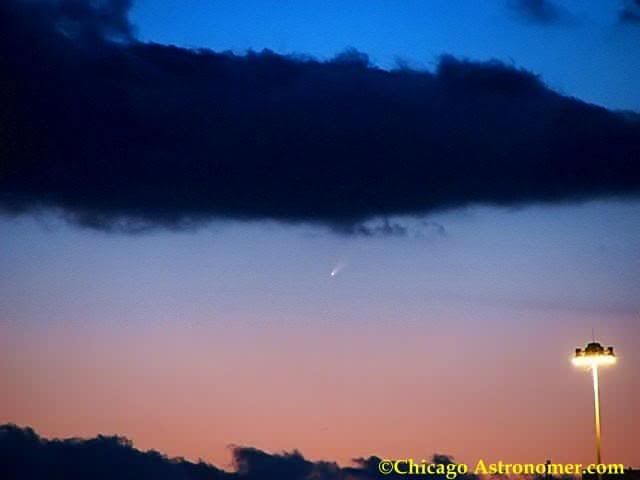Comet McNaught from under Chicago skies...
Chicago Views Comet McNaught
I had the great opportunity to both observe and photograph the comet recently from under light polluted Chicago skies.


Shots were taken with a Canon Powershot S3 IS
More images and full narrative can be found at the Chicago Astronomer:
http://astronomer.proboards23.com/index.cgi?board=Astrophotraphy&action=display&thread=1168410501
It was a great surprise bright comet.
Respectfully,
Chicago Astronomer Joe
Administrator
www.chicagoastronomer.com
Telescope/Observatory Operator
Adler Planetarium & Museum
0
Comments
That anything above can be seen from under Chicago skys from Oct. to Feb. is unusual enough. I haven't even tried lookig for McNaught yet. I gather I'm too late now to get a decent view.
"You miss 100% of the shots you don't take" - Wayne Gretzky
Despite of the light pollution you were lucky enough to have it on a relatively dark background. And you did a great job with your Powershot!
I myself was not that lucky, at least today
Welcome to Dgrin!
Hey welcome to the forum Joe
Great post, we haven't seen many posts of the Comet.
Nice to see you onboard here at Dgrin, and thank you for posting your images of the Comet, dang I wished I'd been able to see.
Time passes you by and then you think, rats I meant to see if I could see that Comet ..... ohhhhhhh well.
Least you got to see it and capture it
Hope you enjoy the forum Joe, and please do keep posting.
..... Skippy
.
Skippy (Australia) - Moderator of "HOLY MACRO" and "OTHER COOL SHOTS"
ALBUM http://ozzieskip.smugmug.com/
:skippy Everyone has the right to be stupid, but some people just abuse the privilege :dgrin
Skip tomorrow (mon) night...if you get a clear view to the west ..search around abouts where the sun was just after its gone down. Cool ?
What I understand, now that Comet McNaught has swung toward the southern hemisphere, observers up north can view the comet in broad daylight, and some even naked eye!
Here is a location map:
Both images from Spaceweather.com
Find a building with a shadow that you can lurk in. Then look around the sky to see the comet. I cant tell you which side of the Sun the comet will be on, because it all depends on where you are on the Earth, so try out a few locations. The comet should be about a fist-widths distance (held up at arms length) away from the Sun, so it will be close.
The comet is now magnitude -5, making it the brightest since Ikeya-Seki in 1965. It it may get even brighter.
You may not see anything at first, but don't give up. Scan the blue sky until your eyes alight upon the comet. Once seen, you'll wonder how you could've missed it.
This weekend is a special time for Comet McNaught because it is passing close to the sun. Solar heat is causing the comet to vaporize furiously and brighten to daylight visibility.
Binoculars dramatically improve the view of the comet, allowing you to see structure within the tail. But please be super-careful not to look at the sun. Direct sunlight through binoculars can cause permanent eye damage.
http://astronomer.proboards23.com/index.cgi?board=comets&action=display&thread=1167964797
If this is so from Chicago, I intend to capture some more images.
It's well worth looking up!...:D
Well dang it Gus, I work afternoon shift so I will be at work poohbum!
.... Skip
Skippy (Australia) - Moderator of "HOLY MACRO" and "OTHER COOL SHOTS"
ALBUM http://ozzieskip.smugmug.com/
:skippy Everyone has the right to be stupid, but some people just abuse the privilege :dgrin
My Gallery
Known as Comet McNaught, it was only spotted for the first time last August by Australian professional astronomer Robert McNaught, when it was just a faint fuzzy blob.
Mr Carter said the comet had brightened up more than anyone expected as the icy lump orbited the sun, ice and dust coming off its surface reflecting sunlight.
"McNaught is now the brightest comet in more than 40 years. . .and it may become the brightest in centuries," Mr Carter said.
Nasa astronomer Tony Phillips told The Associated Press McNaught could turn out to be the brightest comet in recorded history: "It will remain a spectacular comet for weeks, perhaps months, in the Southern Hemisphere".
The comet made its closest approach to the sun – 25 million kilometres – over the weekend and is now moving away, which means it will be easiest to spot in the evening twilight.
Dr McNaught works at the research school of astronomy and astrophysics of the Australian National University. He is a prolific discoverer of asteroids and the comet was the 31st to carry his name.
Mr Phillips said Comet McNaught was six times brighter than Hale-Bopp in 1997 and 100 times brighter than Halley's Comet when it appeared in 1986.
"It will remain a spectacular comet for weeks, perhaps months, in the Southern Hemisphere," he said.
Source: http://tinyurl.com/y7fb2g
===========